September 1 - 30, 2025: Issue 646
Thylacine tales captured for Threatened Species Day 2025 + A few insights into Pittwater's Past + Present Threatened Species
The NSW Department of Environment has released a short film recording the memories of one of the last people to see the Tasmanian Tiger (Thylacine), shining a spotlight on the critical need to protect threatened species from a similar fate.
The last Tasmanian Tiger died in captivity on 7 September 1936 and for the past 30 years this date is marked as Threatened Species Day across Australia.
National Threatened Species Day on 7 September raises awareness of plants and animals at risk of extinction - i.e.: 'threatened by extinction'.
The NSW Government’s Saving our Species team connected with 94-year-old Peggie Bassett and recorded her memories of seeing the last of this iconic species at Hobart Zoo in the early 1930s.
Peggie’s reflects on seeing and hearing the cries of the lonely Tasmanian Tiger remain in the forefront of her mind as a tragedy that should never be repeated.
The loss of this species resonates with today’s conservationists and generations of people who care for Australia’s plants and animals.
Today’s threatened species experts are more committed than ever to stopping further extinction.
Since 2016, the NSW Government’s Saving our Species program has invested more than $175 million in threatened species conservation, actively managing 497 species, 50 ecological communities and 19 key threatening processes.
In that time there have been cautious ‘tails’ of success, namely the discovery of new critically endangered Smoky Mouse populations in southeast Australia and the May 2025 first ever sighting of a Leadbeater's possum in NSW.
Like Peggie, you don’t have to be an expert to get involved in threatened species conservation.
If you have a passion for Australian animals and the natural world you can join a citizen science project, share social media content and keep up to date with projects on the Saving our Species Biodiversity Month page.
The film featuring Mrs Bassett, Dr Sandy Ingleby from the Australian Museum and Fred Ford from the NSW Government’s Saving our Species Program can be found below.
Ms Peggie Bassett said:
“Back in those days … we didn’t realise it was the last one until it was too late. Otherwise, hopefully, they would have protected them even more.
“I think no matter what, we’ve got to protect the animals. They have a right to be here.”
Fred Ford, Saving our Species Threatened Species Officer:
“In Australia we have the luxury of self-awareness of the scale of human impact on our natural ecosystems and species.
“We will never reverse the high number of species extinctions that have occurred in the last 200 years in this country.
"However, knowing more about issues that continue to threaten our native species means we have a clear moral obligation to try and mitigate the impacts we are having.”
Throughout the years of this news service insights into animals and plants that once thrived in Pittwater have been run, as updates to the NSW Threatened and Critically Endangered lists are published, along with historic insights into the animals that once lived here, eve those that have disappeared - such as the koalas that once thrived across Pittwater, or the fairy penguins that once had a colony on Turimetta beach and swam at Narrabeen or the wallabies that would be seen on Mona Vale beach.
That is why so many residents object to the council supporting a push to allow dogs offleash on this beach - turning the clock back 100 years on local council policy to protect the wildlife, children and residents on this public beach. Already this week those who walk along this beach on a daily basis have reported dogs offleash on it - before any mid-October 12 month 'trial' begins - and having to pick up plastic dog poo bags, with dog poo still in them, left on the beach.
Pittwater residents state the council is breaking two NSW laws in this - the first to ensure dogs are kept on leads in public spaces, the other to protect wildlife from being chased from feeding grounds or being put at risk of attacks.
See:
- Northern Beaches Council recommends allowing dogs offleash on Mona Vale Beach
- Council push for dogs off leash on family beaches among wildlife habitat
- Fairy penguin found on Pacific Highway returned to Local Pacific ocean waters
- Watch out, Shorebirds are Permanently About and now building nests - With More Annual Visitors coming from this Month!!
- Seals Hauling Out Along Our Beaches: Register these on the NSW Haul-out, Call-Out seal survey
- Project Penguin 2025 + Surfing with a Penguin in South Africa + Pittwater's Penguins
- Pittwater's Little Penguin Colony: The Saving Of The Fairies Of Lion Island Commenced 65 Years Ago This Year
Dogs attacking koalas are one of the key contributing factors for there no longer being any koalas in Pittwater.
See: Pittwater's Koalas Driven to Extinction: Some History
Sick Koala Had Left Baby Safe
An emaciated koala, found with a broken leg which the ants were already attacking, in the deserted bush at Palm Beach, is thriving at Koala Park where it was taken.
After the leg was placed in splints, the bear was thoroughly examined and experts stated that its pouch had recently been occupied. There was no sign of the baby. Immediately a search of Palm Beach was organised and the baby was located in a low tree, just outside the reach of dogs.
Kidnapper
He also was taken to the Park, but when his mother was too weak to nurture him. was handed over to Boorabee, the Park's recognised foster mother. Despite her 17 years, Boorabee has keen maternal instincts, as is evidenced by the fact that this is her second foundling for the year. When she has no baby, Boorabee sets herself out' to steal one. She was formerly In a circus, where she learned to Imitate a monkey's shriek, and attendants know there is trouble when they hear her imitating a monkey. The mother Is now quickly regaining her strength. The director of the park (Mr. Noel Burnet) said yesterday that in ordinary circumstances koalas could never break their legs. In this case, he believed a dog had bitten it, or that it had been broken when the tree she was in was felled. Sick Koala Had Left Baby Safe (1938, February 27). The Sun (Sydney, NSW : 1910 - 1954), p. 1. Retrieved from http://nla.gov.au/nla.news-article231114754
KANGAROO'S SWIM FOR LIFE
An "old man" kangaroo found fighting desperately for his life in the surf at Mona Vale on Monday afternoon was assisted ashore by bathers, only to be attacked immediately by dogs. The dogs were beaten off by surfers, and the kangaroo hopped unsteadily into the bush and disappeared.
For more than a quarter of an hour those on the beach could not make out what it was bobbing up and down with a peculiar motion in the far line of breakers. As it drew nearer it was identified, and the sight was so unusual that soon a crowd was assembled on the edge of the water to watch its progress. This nearly proved the kangaroo's undoing. Becoming aware of his "gallery," he stopped in fright, and was in danger of drowning.
Bathers went out, however, and eventually persuaded him to continue towards the shore.
He was too exhausted adequately to deal with the dogs which immediately attacked him. The surfers again had to come to his assistance before he escaped to the security of the bush.
It was suggested by a bushman that the kangaroo might have been chased from his usual haunts by dogs, and when cornered on the seashore jumped into the water as a last desperate resort. KANGAROO'S SWIM FOR LIFE. (1940, October 8). The Sydney Morning Herald (NSW : 1842 - 1954), p. 7. Retrieved from http://nla.gov.au/nla.news-article17707829
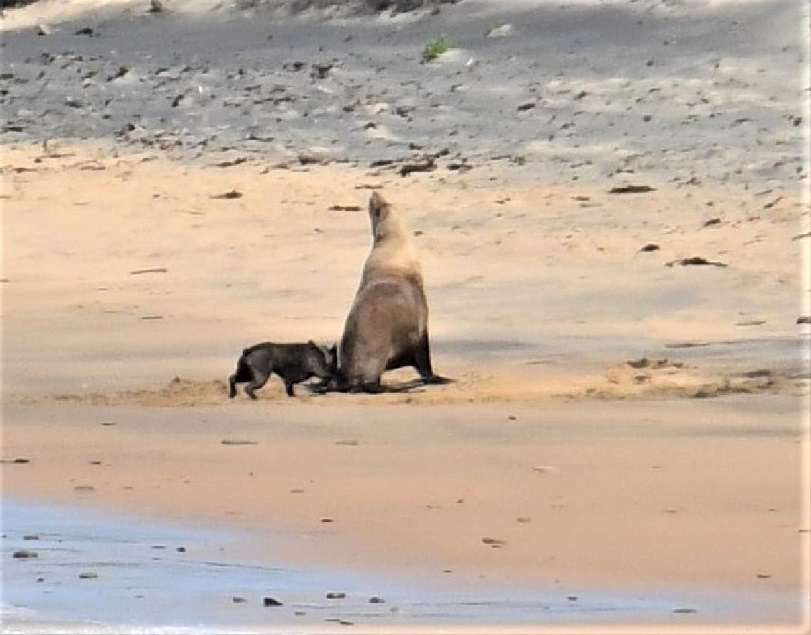
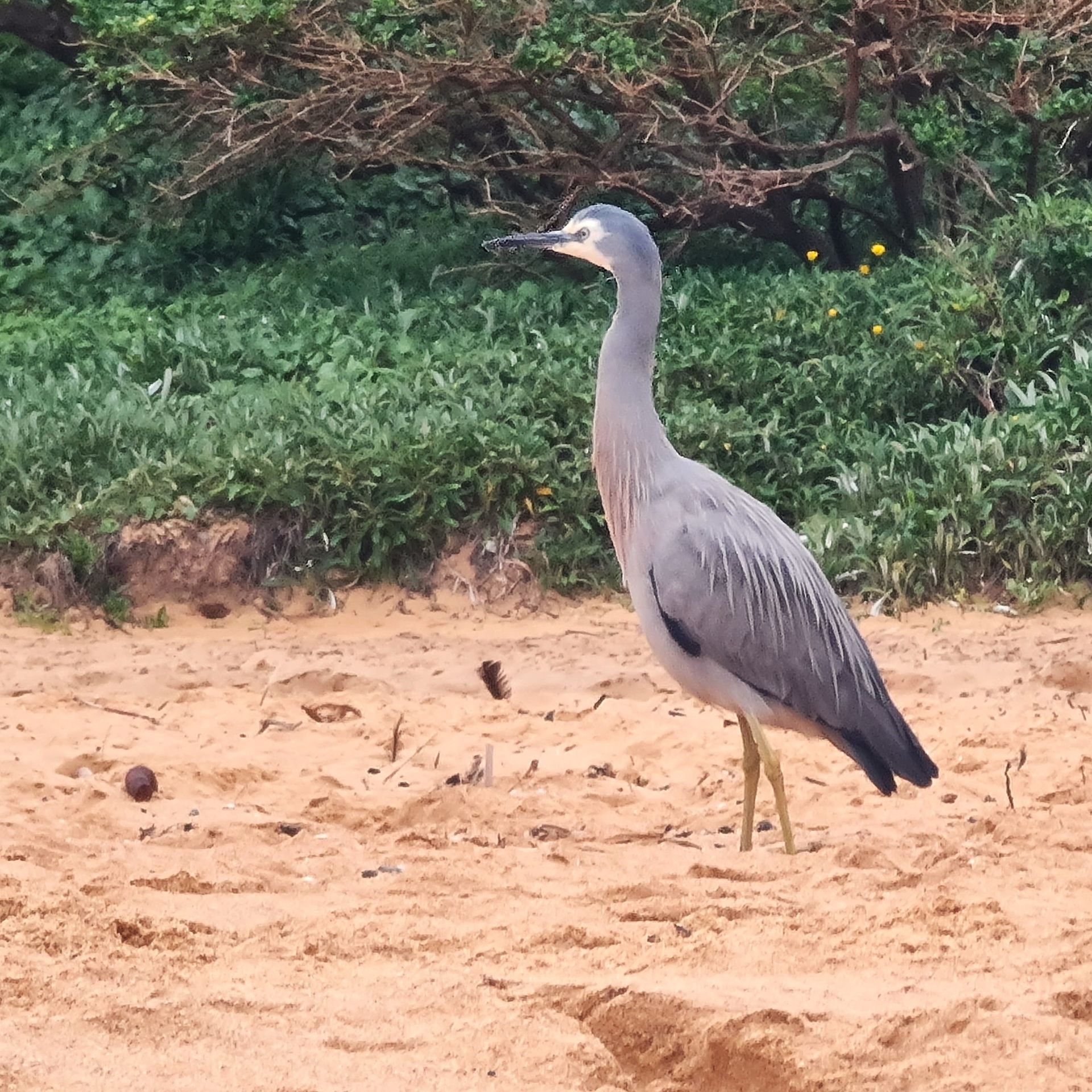
White-faced Heron foraging for food on Turimetta Beach. Photo: Joe Mills
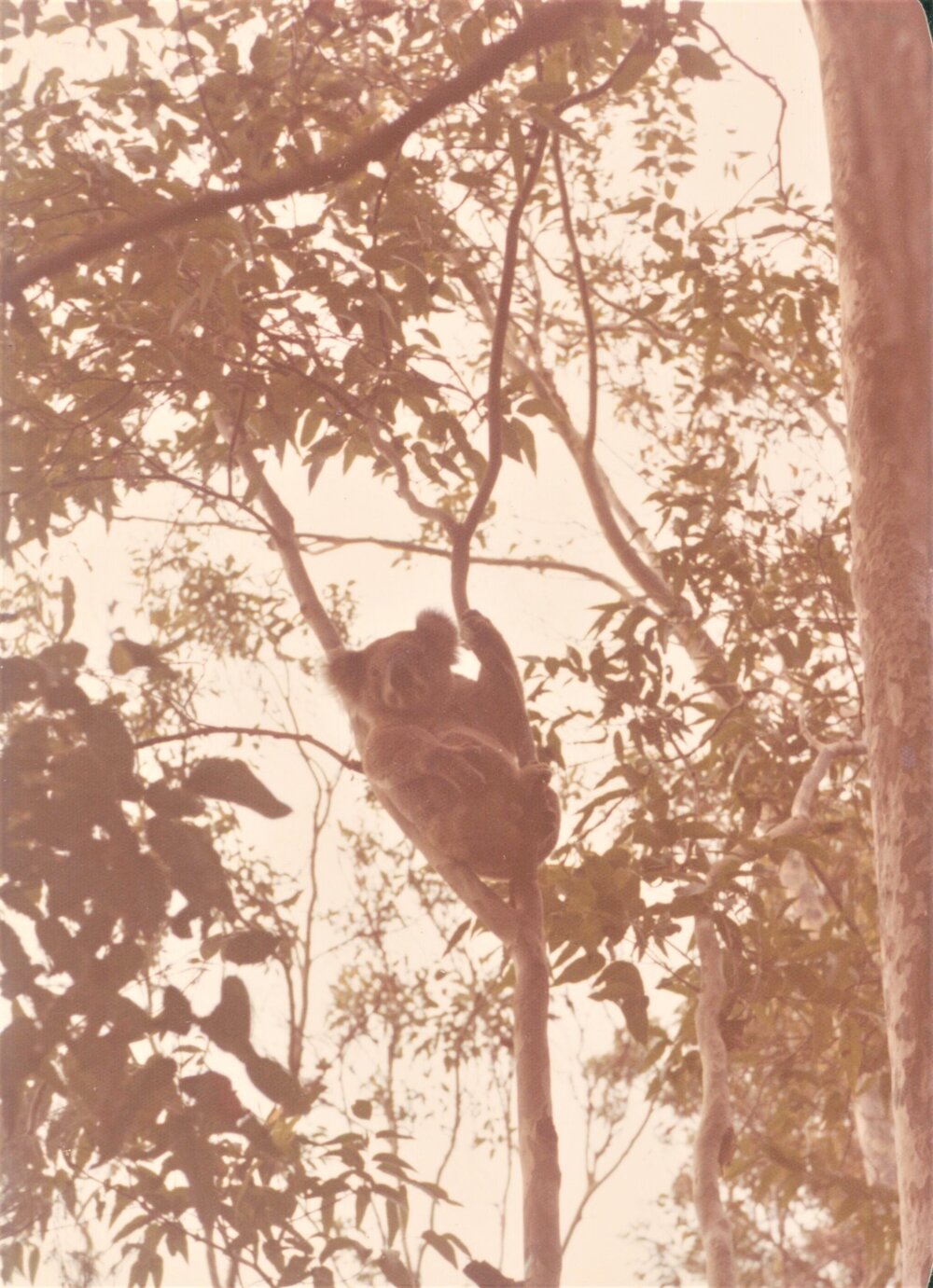
Koala and her joey in Grandview Drive, Newport. Photo: March 1974, taken by Lynette O'Neill (R.I.P.)

The release of an 8 years old female back into Angophora Reserve after she had been bombarded by magpies. Taronga Zoo picked her up and nursed her back to health before the release on November 5th, 1989. Doug Bladen and Marita Macrae are in the background representing the Avalon Preservation Trust (now APA). Photo by Geoff Searl OAM
However, historically people have been using Pittwater as a place to hunt wildlife for 'sport' since Europeans landed here. Charles de Boos 1861 published 'My Holiday' recounts gong hunting in a walk from Manly to Barrenjoey, with 'kangaroo dogs' to help them flush out and kill wildlife. They started from the aptly named 'Kangaroo Hill' at Manly - once a place kangaroos thrived until they were hunted - into extinction - at this location.
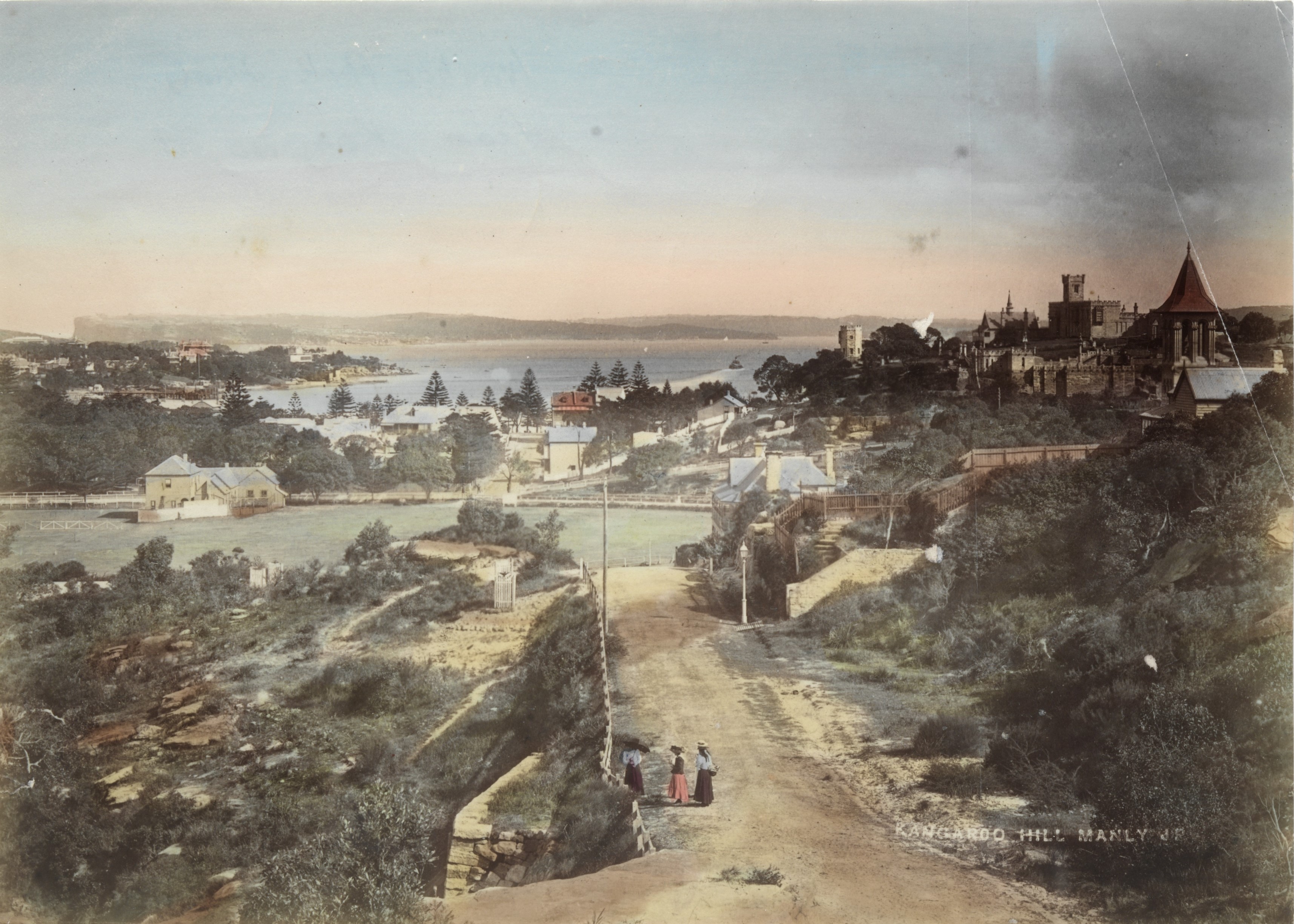
Kangaroo Hill, Manly, ca. 1880-1898, courtesy State Library of New South Wales, Item: SLNSW_FL1109634
Thankfully, or as a sign of what had already occurred, the trio trudging on the hunt from Manly to Barrenjoey did not encounter much left to kill - but resorted to shooting, maiming and wounding. Near Narrabeen he recounts:
There was a large flock of sand pipers, small birds, somewhat about the size of a lark, but with long lags like a snipe, that were running about the sand picking up their morning meal. I tried very hard to got a shot at them, .but they ran away so fast and kept themselves so pertinaciously out of gun-shot that at last I let fly haphazard at them, and of course got nothing.
Many of these species can no longer live at Narrabeen but may be found at Long Reef aquatic reserve - although just recently several were listed as Threatened with Extinction in NSW.
See: NSW Threatened Species Scientific Committee final determinations for July 2025: 6 new species Now Critically Endangered or Vulnerable to Extinction -an orchid + the grey plover, black-tailed godwit, ruddy turnstone, sharp-tailed sandpiper, red knot - (The main threat to the grey plover in NSW and Australia is habitat loss and disturbance at feeding and roosting sites, particularly disturbances from human recreation and off-leash dogs.)
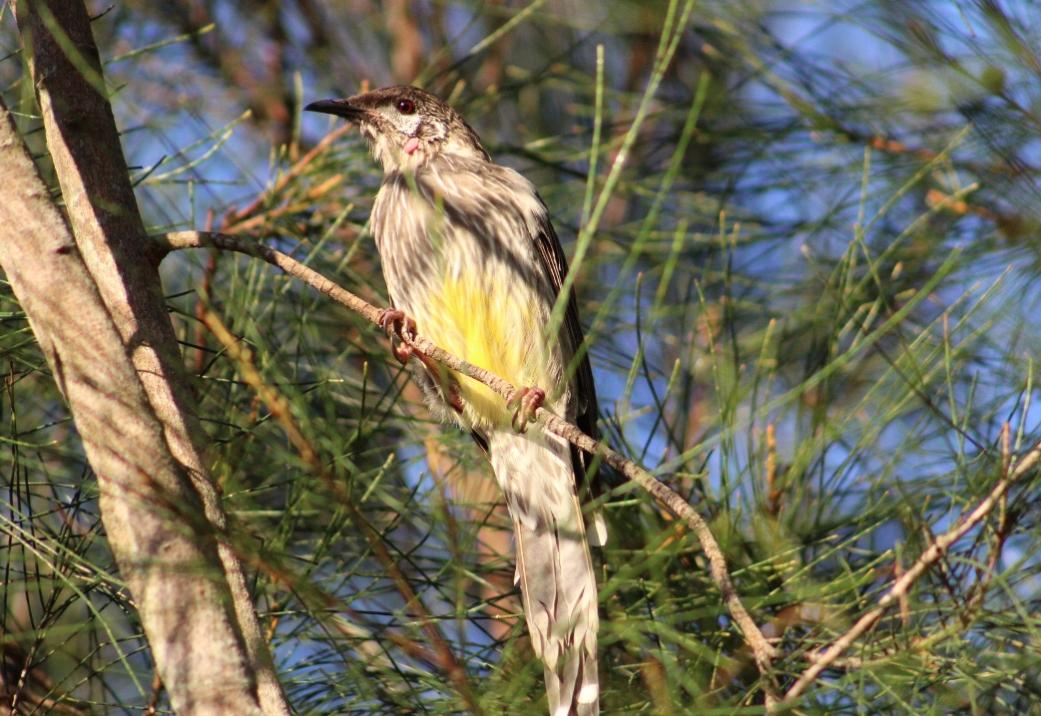
In the coastal brush and heath of the Barrenjoey tombola, having killed no 'gill-birds' (Sydney wattle birds) - a species apparently slaughtered in its thousands locally for 'sport'- they train their guns on wonga pigeons:
Nat audibly gave vent to his dissatisfaction, and stated as his private and particular opinion, that we had been humbugged. He uncocked his piece and threw it over his shoulder, whilst I was in the act of doing the same thing, when whirr !-up with a loud flapping of wings, that from its suddenness quite unnerved me and threw me off my guard, rose a magnificent wonga wonga, which in my agitation appeared to me as big as a turkey. It heeled round leisurely in front of me and lodged in the branches of a honey- suckle, full in sight, though out of gun-shot from where we stood, whilst I stood with mouth and eyes open, incapable of doing anything but watching its flight.
"What the mischief was that?" said Nat, in evident astonishment at the sound.
“Didn’t you see it? " I asked.
" Not a bit," he replied.
"It was a wonga, and as large a one as ever I saw. See, there he is on the honeysuckle vender, the fourth bough from the top."
"I see him," shouted Nat, as he darted off into the bush.
He fumbled about for nearly ten minutes, but once in the scrub, couldn't make out the particular tree. I directed him as wqell as I could, every now and then sending him to the right or left, according to the position whence his voice came. At last, tired of this finger-post business, I determined upon trying for the tree myself, and having carefully laid down marks and directions entered the bush. Two or three twists and turns round clusters of Ti tree, or out of the way of dead timber, and then all my marks and points and guides, had vanished, and I knew that I was done. So I wisely retreated to the clearing, shouldered my piece, and walked away off in the direction of the station. Nat soon joined me, rumbling and growling at not having been able to find the bird, and abusing me for not shooting it when I had the chance. I only wish it had risen up under his nose instead of under mine, to have seen whether his nerves would have stood such a shock.
As we came up to the place we observed Tom, and what we conceived to be two other persons, standing on a high sandy ridge near the house. One of these was Mr. Ross, the Custom-house officer, stationed here...
More in My Holiday By Charles de Boos – 1861: Manly to Barrenjoey
It's not just that this went on for a long time more, even looking further back records recount the killng of pecies no longer resent in Pittwater due to wilful killing.
Another bird, not seen here since, was shot, during breeding season for this species, and then what appears to be its mate was shot a few months later, during the nesting season. That bird was, and is, the Black-necked stork, Mycteria Australis, a tall long-necked wading bird in the stork family - and in this instance, Australia's only stork:
DONATIONS TO THE AUSTRALIAN MUSEUM DURING APRIL, 1855.
A fine specimen of the male gigantic crane, Mycteria Australis, shot at a lagoon, near Pittwater. Mr. George Lamont, Pittwater. DONATIONS TO THE AUSTRALIAN MUSEUM DURING APRIL, 1855. (1855, May 7). The Sydney Morning Herald (NSW : 1842 - 1954), p. 5. Retrieved from http://nla.gov.au/nla.news-article12968963
See: Black-necked stork, Mycteria Australis, now endangered in NSW, Once Visited Pittwater
.jpg?timestamp=1567239765467)
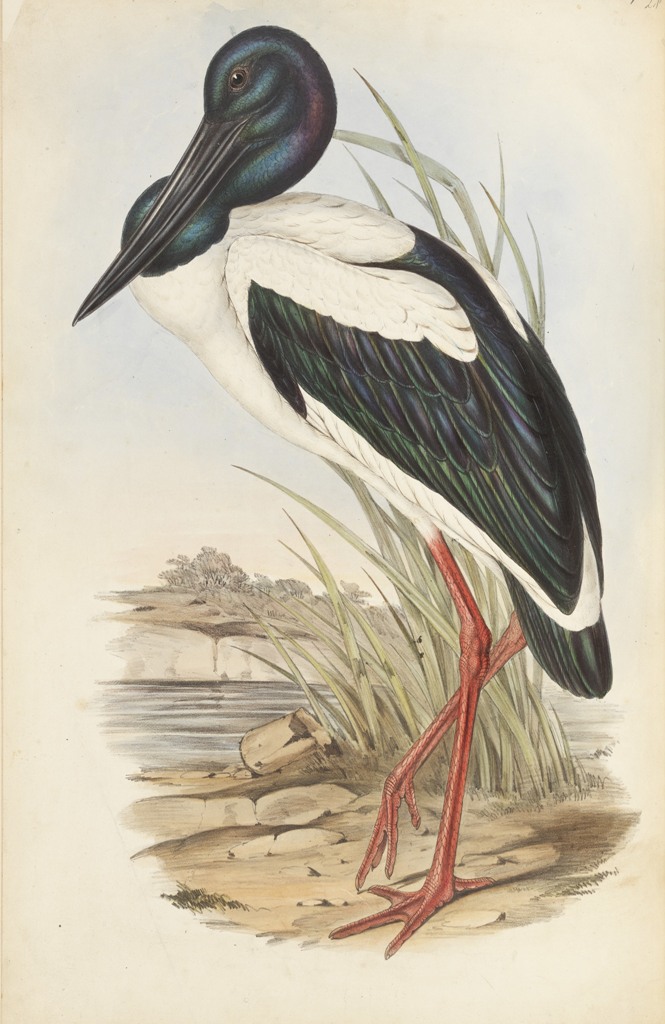
John Gould MYCTERIA AUSTRALIS: Vol 6 plate 51 of The Birds of Australia. Published date: 1848. Digital ID: IE4644479, courtesy State Library of NSW
In fact, every other species of the doe eyed, furry, feathered and scaly skinned that calls or once called this place home was targeted by the self-entitled short-sightedness of humans. Flying foxes, a keystone species that ensures a healthy environment, were hunted by orchardists at Warriewood and Ingleside.
This species continued to be killed or wounded by shotguns, many remaining disabled where they fell after the bounty was stopped, despite the advice of Ratcliffe and later researchers on an ineffective and uneconomical practice and the needless extermination of the population.
FOXES FLEW
HUNT THAT WASN'T MONA VALE BATTLE
It was the strangest of fox hunts No red coats flashed. No horses streaked across" the landscape. No hounds bayed or waggled their wet red tongues.
No hunting horns sounded echoing blasts. No pretty huntresses skimmed across fences, with the tang of the tonic air turning cheeks pink. And, strangest thing of all, there was no fox! It all happened not at a romantic-ally-named Chevy Chase or Tavis tock 'Downs, but at prosaic Cabbage Tree Gully, Mona Vale. It was a severely, masculine affair— only men and boys and fox terriers and guns.
But It was not a hunt. Certainly it' was intended that it should have been more. Flying foxes have been swooping down from the forest-terraced hills beyond Mona Vale. Like mountain brigands, they have raided the orchards about Newport, Pittwater, and as far afield as Pymble. A trail of peaches, apples, and early plums, all scarred by tiny teeth, has been left under the trees. This tyranny became remorseless. Flying foxes have been getting the fruitgrowers under their iron wing. So war was declared. The whole district rose up in revolt. Rifles were oiled. Cartridges were gathered. Dogs were given more meat. Scouting par ties went out.

The flies were bad in Cabbage Tree Gully, near Mona Vale yesterday, when the people of the neighbourhood organised a flying fox battle. This sportsman, at any rate, was determined that his aim should not be spoilt.
IS IT WAR!
Someone spoke of a LEWIS gun. Someone else told how one had been trained on a big ironbark whose every branch "was draped with clinging foxes, it had failed miserably, chopped off branches and- only scattered the, inhabitants. A youth suggested poison gas. He was eyed with indulgent pity.
"Shoot 'em out!" was the verdict of the oldest bushmen in the district. It went. Guerilla bands yesterday morning gathered in a paddock of ferns near the Pittwater-road. Grim sun-tanned men strode out or the bush with guns, and bandoliers! Aged bushmen, hardy warriors with Visors of fly net across their lulw. strode out of the bush with guns and bandoliers! Boys of 16 and 17 strode out of the bush with guns and bandoliers! Two fox terriers playing the role of the pack of hounds had the light of battle in their eyes. Cicadas on every side did more baying than any string of dogs. ;
ARMY ON THE MOVE
On Wednesday the lair of the flying bandits had been found. Many hundreds of them gave a couple of iron-barks and sheoaks a living brown-grey foliage in a wall of green on a 'hillside.
"You can't miss 'em," said one optimist.
"I'll lay three to one you don't get a fox," retorted Gus Anderson, who knows every piece, of fern from Narrabeen to Newport.
Then began the climb up the gully. The armed party looked like a Boer commando or one half of a Kentucky feud. Later It looked like a string of Tyrolese mountaineers as men and boys shinned and slid up and down brown rock faces and the steep -timber strewn wall of the gully.
They fought through waves of ferns and wild palms and wild apple Scrub. They crept through black aisles of sheoaks, turpentines, and Ironbark, gloomy as a pillared cathedral. Then across the gully rattled a shot. "It's all right, it's only a pigeon, blokes," echoed a far-away voice from the green ocean of leaves.
Hopes that had soared crashed again.
"Keep quiet, we'll hear 'em squeal, ordered someone. The punitive expedition, even to the terrier, seemed to hold its collective breath. But when you began to listen Intently It was brought home vividly how really clamorous the bush can become. Birds screamed and chattered, and the symphony of the cicadas had swelled to a crashing chorus.
"Blow'd if a man could hear them squeal," exclaimed one hunter, disgustedly.
NOT A FOX SEEN
After what seemed an age of scrambling over dry logs and slipping on oak needles the bandits' lair was reached. Not a fox draped a twig. Faces fell.
Tired men and boys sank on to logs.
"Gus Anderson was right. They’ve gone to Deep Water Creek," they panted.
Striking toward the coast, the army worked through the moist heated forest to the head of Cabbage Tree Gully and around to Spear's Point; a butto of rock that rises from .the bronze green forest ocean. Not a fox was seen. Shots were fired. But, there was no squealing scurry from the branches.
An aged fruitgrower at Cabbage Tree' Gully turned disappointment to despair. He said he had not seen a flying fox over his fruit trees for two days — not since a boy had a few shots from a pea-rifle somewhere in the gully on Thursday. The army halted. Faces glistened with sweat.
Everyone was hot. tired, and dusty.
A Mona Vale David, single handed, had put to flight the winged terror to which 30 men had sought to give battle.
The flying foxes had flown!
Hunters were out till last evening, but no reports were received of the foxy bandits having been traced.
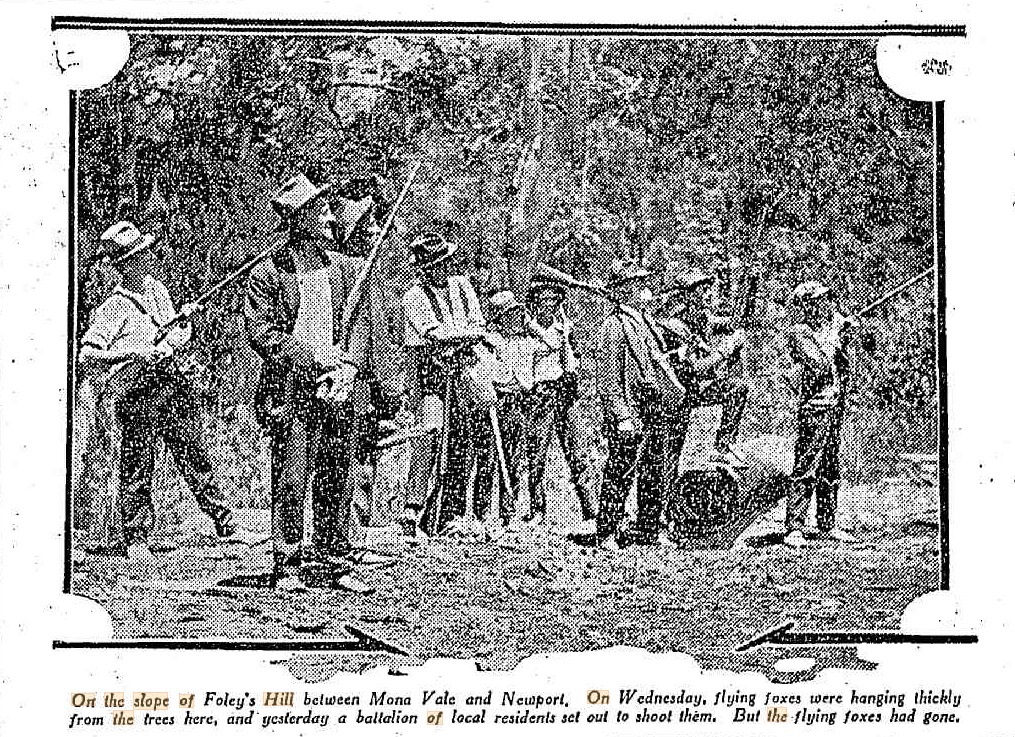
FOXES FLEW (1926, December 5). The Sun (Sydney, NSW : 1910 - 1954), p. 5. Retrieved from http://nla.gov.au/nla.news-article224130852 -
It's not just the many specie of wildlife that have been ill-treated by locals over successive generations.
Plants had to be cut down if trees, for profit, and pulled out by the roots if flowers - to prevent others profiting. Founder of the Kuring-Gai Chase National Park Eccleston Du Faur recounted in 1892:
KURINGGAI CHASE. TO THE EDITOR OF THE HERALD.
Sir,-When on 6th October, 1892, I first submitted officially to the Minister for Lands the proposal to "dedicate the waters of Cowan Creek, and ... adjacent to same, as a national park for North Sydney, one of the principal arguments adduced was that "steps could be taken to prevent the reckless destruction of native flowers .eg, the rock-lily, formerly so abundant, is becoming scarcer every year, and must soon become extinct it not to some extent protected."
Two flowering seasons passed away before my suggestion was adopted by the preliminary notification of Kuringgai Chase in the Government Gazette of 20th June, 1894. During that interval of over 20 months wholesale depredations had been committed, not by the tourist but for trade purposes which left the foreshores for miles denuded of the special vegetation which had made them attractive in former years- the last tree ferns had been cut down, the rocklilies almost extirpated (the cutting of their flowers did no permanent harm, but almost every accessible plant had been torn away by the roots, and hundreds of Christmas bush trees of fifty growth and upwards had been felled, merely to lop off the top branches for decoration of the butchers shops &c.in Sydney). The removal of a few cartloads or boatloads of such vegetation each year would not have done any irremediable damage, but many of the depredators made a practice of camping on the creek for a week or two before Christmas and ruthlessly destroying everything they could find in accessible places, which they did not want for themselves, in order that others might not join in their harvest and cheapen the market against them at Christmas time.
…. December 17. E. DU FAUR, trustee. KURINGGAI CHASE. (1894, December 18). The Sydney Morning Herald (NSW : 1842 - 1954), p. 6. Retrieved from http://nla.gov.au/nla.news-article14000128
See:
- Pittwater's Lone Rangers - 120 Years of Ku-Ring-Gai Chase and the Men of Flowers Inspired by Eccleston Du Faur - 2014
- Stealing The Bush: Pittwater's Trees Changes - Some History
- Pittwater’s Parallel Estuary: The Cowan ‘Creek’
- The Cowan ‘Creek’ + Lovett Bay Heights Tracks: Some Notes From The Pages Of The Past With Early Photos
An 1889 account by one of the Quinn brothers of Manly, Patrick, writing under his pen-name describes the area of Rocky Point Pittwater, as 'Viator':
A RUN TO PITTWATER
BY VIATOR.
"For what reason do the tall pine and the white poplar love to associate their branches in a hospitable shade?" was the question put by one of old who knew how to enjoy the good things of life to his friend Dellius. To the epicurean no verbal answer was necessary. The friendly trees made this grateful shade so that he might lie upon it in remoto gramine per dies festos and drink the good Falernian. This is the true way to look at life, as only the men of a fairer day knew it. For them-true beauty worshippers - the sea danced and laughed in the sunlight, the fleecy clouds were blown across the clear blue of those astounding skies, and the winds made a pleasant susurrus in the deep woods, and the birds sang, and the bees made sleepy music and sweet store of honey : for them the cataract roared, the grass grew and the violet crept across it, and the whole world lightened on its way simply to add to their pleasure. And all the wisdom garnered since by this wise old world shows that they were, in this right, by reason of philosophy, as simpler people were by intuition, who did the same. The other day I had an opportunity of spending a few dies festi on one of the many arms of Broken Bay.
To those who have not journeyed to Pittwater it is, perhaps, necessary to say that the route via Manly Beach is the most convenient way of reaching it. When the passenger arrives at Manly the Pittwater coach awaits him, and a drive of an hour and a half will land him at his destination. If the weather is gray and cold the trip should not be at- tempted. To be seen at its best Pittwater should seen in sunlight . There are several houses of accommodation about which offer the traveller all the necessary comforts. For my part I put up at the house of a friend who has one of the loveliest spots on the coast. Part of his land forms a peninsula, with deep, rich soil, in which the fig, the lemon, the orange, the olive, and the vine flourish to full perfection.
There was at one time some excellent timber growing along the Pittwater road, tall, straight, sound, close-growing trees, which have for the most part disappeared under the woodman's axe within the last five years. This is a pity, but perhaps it could not be otherwise. The forest was too close to Sydney to escape the attention of wood merchants. There is still, however, quite sufficient native woodland to give the proper rustic air to these regions. How long this will be so under our present reckless system of forest destruction it is impossible to say, but those at least who own mighty tracts of virgin land along this road should endeavour to protect the native growths as far as possible from annihilation. We will regret our apathy in the matter of preserving our woods some day, when it is too late, perhaps, as the Herald has often pointed out, for anything but regrets.
Something at least may be said in favour of the sense of beauty of the inhabitants of this district. Along the road every now and then the traveller may catch a glimpse of the graceful aspiring crown of tall, slender cabbage palms, which have been spared by the ruthless hands which have destroyed so much besides that was beautiful. Two or three handsome growths stand like sentinels on either side of the road, though the army which they guarded has long since faded away - ended in smoke probably. The cabbage tree splits easily into light serviceable planks, and this made it much sought after for the gunyah of the early settler. When dry it burns like tinder, and these two fatal qualities have been its ruin. A few, as I have said, still remain. One magnificent specimen, standing back some distance from the road, must be from 80 to 100ft in height, and with its plumy head and symmetrical trunk visible among the amorphous forest shapes about it, is full of graceful tropic suggestiveness. There are one or two other species of dwarf palms scattered about, which have failed to attract the attention of "flower show" prospectors - a class of people whose ruthless hunt after specimens is responsible for a large proportion of the destruction which has visited our most ornamental native plants.
The road traverses the Narrabeen lagoon, an imposing marine "billabong," such as our coast has several notable examples of. These are connected with the sea, either by a shallow channel with a sand-bar across it, or as in the case of the Narrabeen lagoon and that of Curl Curl nearer Manly, are severed from the sea, by a sandbank, which, however, offers no impediment to the influx of the sea under the influence of a spring tide or a heavy easterly wind. These are the true nursing grounds of our young fish. Within those charmed waters the shark may not enter to disturb their peaceful inhabitants. By reason of the clear sand bottom they are beloved of the sole, the sand-flathead, the whiting, and the sand mullet which reproduce in the tender complexions of their bodies something of the transparency of the waters and the whiteness of the sand. Consequently the Narrabeen is a favourite resort of camping parties, which, rumour hath it, have never yet gone unrewarded from its shores.
There is a pretty legend about the name of this lagoon, which it is said was first born by the dusky daughter of a lord of the soil and a chief of his people. This chief had planned it in his black head to destroy a party of white men located at this spot; but Narrabeen flew to Manly and informed the authorities, bringing back help in time to rescue the party. This pretty legend does not state that Narrabeen was in love with one of the white men, but surely this must have been. What became of Narrabeen is not stated, but knowing the character of some of the early settlers, and the manner in which the blacks were treated, it unquestionably could not have been ill for her if she found an early grave in the clear water of the shining sheet which bears, and shall always bear, her name.*
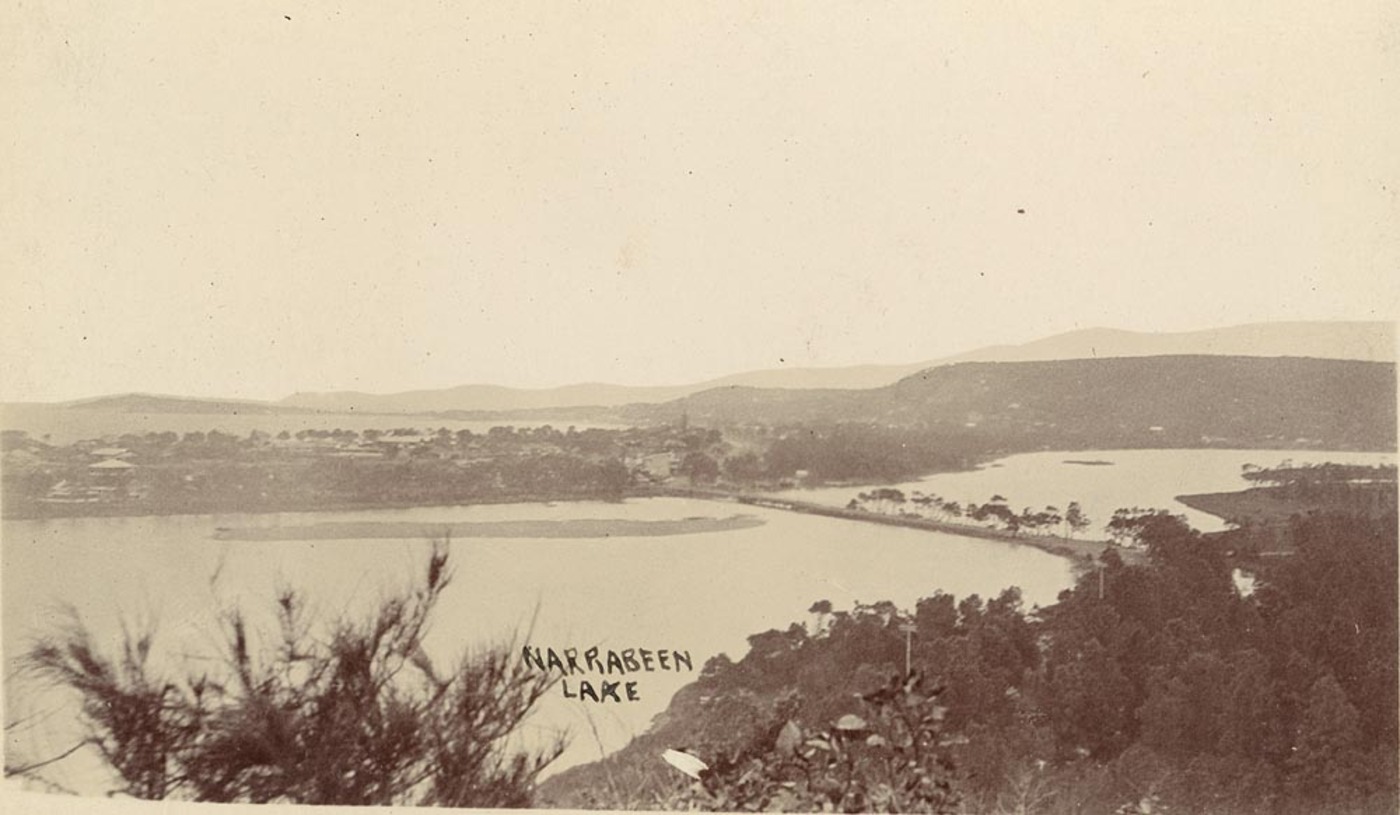
Narrabeen Crossing. Image No.: a106063h From Scenes of Narrabeen album, ca. 1900-1927 Sydney & Ashfield : Broadhurst Post Card, courtesy State Library of NSW.
Across the lagoon in a direction different from that taken by the road the telegraph line takes a short cut, passing the water in a few giant strides. Not very long ago the coaches had to pass through the water too, and this must have conduced to many a good ducking suffered by the traveller of the past. On some of the lagoons, which are plentiful along this road, the black swans congregate at certain seasons, probably when the hot breath of the drought has made them fearful that the inland waters were about to forsake them altogether, as Lake Albert and other extensive sheets of water actually do in a season of prolonged dry weather. From time to time, from an elevation over which the road passes, the traveller catches a view of the coast as far as the famous headland of Barranjoey. Bluff after bluff fronts the sea in curious and beautiful regularity, now calm and clear in contour as the cuttings in a cameo, now veiled in a light blue mist, which bestows harmony and tone on the scene, and whose impermanent curtain every breath of sea-borne air momentarily dissipates. On a bright, clear day this view, which may be obtained from the hill lying between Fairy Bower and Manly Beach, is superb. But our two stout horses stay not for the picturesque, and we soon arrive at Pittwater, an arm, as every one knows, of Broken Bay.
This latter inlet is for once well named. Equally happy is the title bestowed on Lion Island, that grim image of stone rudely shaped by Nature to keep perpetual watch and ward over the picturesque waters within, and appropriately gazing over the ocean, from which the white sails and black smoke of the enemy of our long tranquillity are some day to spring. According to General Schaw the defence of Sydney will be incomplete until Broken Bay is strongly fortified. Was it to emphasise the weakness of the place that this Titanic lion was placed in frowning strength immovable in the war of winds and the whirl of waters? Absit omen. It may yet be renowned in history ; it surely will in romance. What significance could be drawn from its apparently meaningless symbolism Hawthorn has shown us in the " Great Stone Face." To the majority of the world, however, this rock is like the rock in the desert from which the Israelitish leader smote the living water. We poor exiles might touch it with our little wands for years, and all in vain, until the due hierophant comes along and strikes it with his sacred force, when, behold, a spring of glittering song or sparkling prose gushes out which we all rush to drink. And forevermore the spring is as much ours as his who caused its pure initial flow.
After a journey there is nothing more pleasant than the after-tea gathering about a glorious wood fire, sipping the mellow liquid that glimmers in polished glasses, while every head is dimly seen bulking through a nebulous halo of aromatic smoke. My host had Theosophistic tendencies, and before long the conversation turned on the doctrines of the esoteric Buddhists. It is curious that quite a number of intelligent young Australians appear to be opening their mouths to swallow this many-humped camel of the Orient. Men who scorn the faith which accepts the Christian miracles are willing to receive as truth the tremendous miracles of the Theosophist, and do this without any apparent sense of the incongruous. Theosophism, however, can only be a vogue. It will never lay hold of Western minds as it has fastened on the men of the East. It has its foundation in the mind and not in the heart, and consequently it is a system and not a religion.
But it is curious to note that it is growing here - most curious to hear its strange esotoric doctrines discussed in the spirit of a disciple in this isolated cottage, with all about it the mild growth of Australian life. How near we are to primitive nature is evidenced by the presence of a little black lizard, which, attracted by the warmth, comes out of some secret hiding-place and creeps towards the strange and beautiful fire which lures it to its doom. Outside, the southern stars blaze in the lucent night with a brilliance undimmed by a day of smoke. The dark waters sleep beneath, tranquil and secret.
There is a philosophical foreigner inhabiting these regions whose wont it is to row out on the water in his boat and fill himself up with whisky. His last wilful acts are to set the sails of his boat and then lie down to sleep, letting his bark go whithersoever the winds of heaven list. For hours this fatalist drifts hither and thither before his boat is driven to land. It is a whimsical enjoyment truly, but one that instinctively commands respect. He in his boat and we on the shore are in much the same position, drifted hither and thither, willy nilly, by winds and currents known not of till our boats ground upon the shore. We talk about the insularity of the Englishman, while humanity itself is, and always has been, insular. When the first man gazed on the first stars ever beheld of human eyes, he probably imagined they were made for his delight. We know that of old it was firmly held that the sun was a satellite of the earth, and even now it is the common belief that the little spheroid on which we have our being is the control globe of a system as wide as God's own mind - the only planet upon which life is found. Those stars above most of us think are shining deserts made without a purpose, or, if for a purpose, for that of shedding an infinitesimal ineffectual portion of their lustre on our inefficient eyes. All this springs from the inborn insularity of the race. In the end, when the whole scroll of creation is unrolled, as it may be, before our purged vision, how small a portion of it all this little earth of ours may prove to be. And yet, despite this possibility, how infinitely cock-sure mankind is, and always has been, about its own importance. It is a positive relief for one who perceives this weakness, and who probably shares it, to think that somewhere in a starless roadway of space, unnumbered millions of leagues away, a huge comet may even now be on his way to batter the earth and its egotistic inhabitants to dust, smiting one side of the globe before the inhabitants of the other are conscious of its dread appearance in the sky. Would such a planetary catastrophe cause a single quiver in the nerves of the universe ? And yet there are those who believe that earth is the universe. We may be sure that the philosophic foreigner aforesaid is not one of these, but has a due conception of the helplessness of the race of which he is a distinguished atom. It is this Universe itself which the modest theosophist wishes to make the stool of a foot which must wear boots, and is liable to corns - the elongated degenerated hand, perhaps, of the tertiary troglodyte.
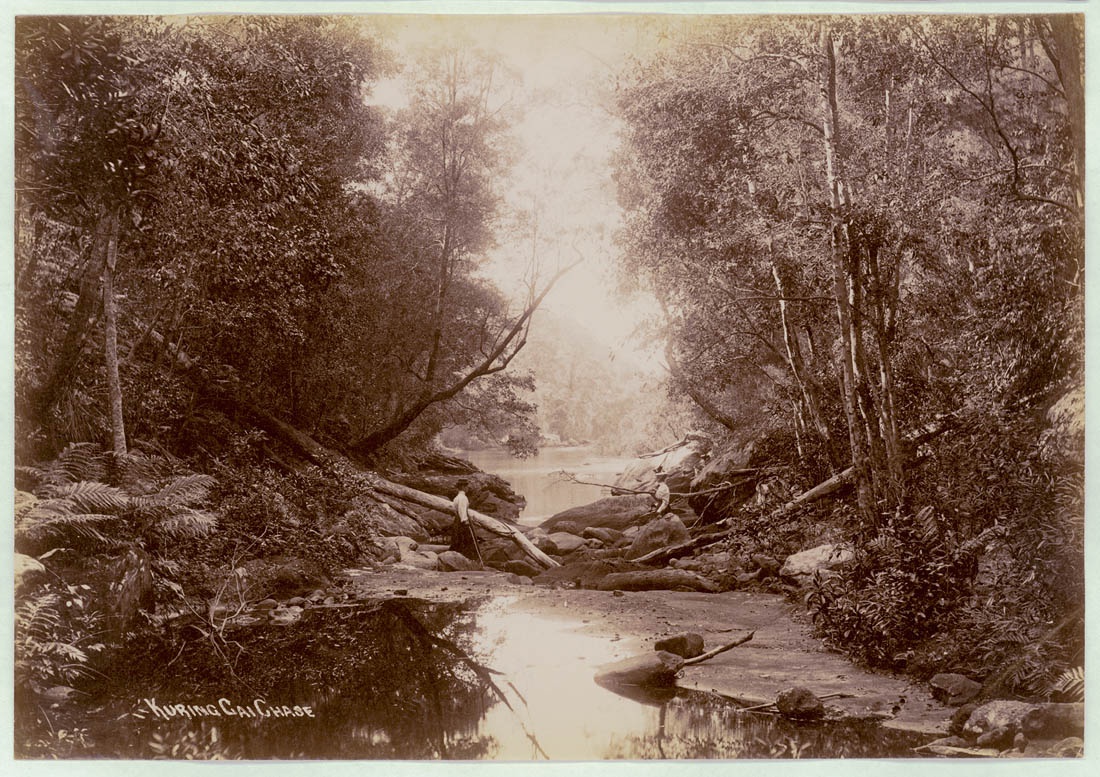
Right: Head of Lovett Bay - from Photographs - New South Wales, 1879 - ca. 1892 / N.S.W. Government Printer. Image No.: 294068h, courtesy State Library of NSW.
In the cool early morning I took a stroll through the garden and orchard surrounding the house, on whose trees late oranges and lemons of unusual excellence were still pendant.

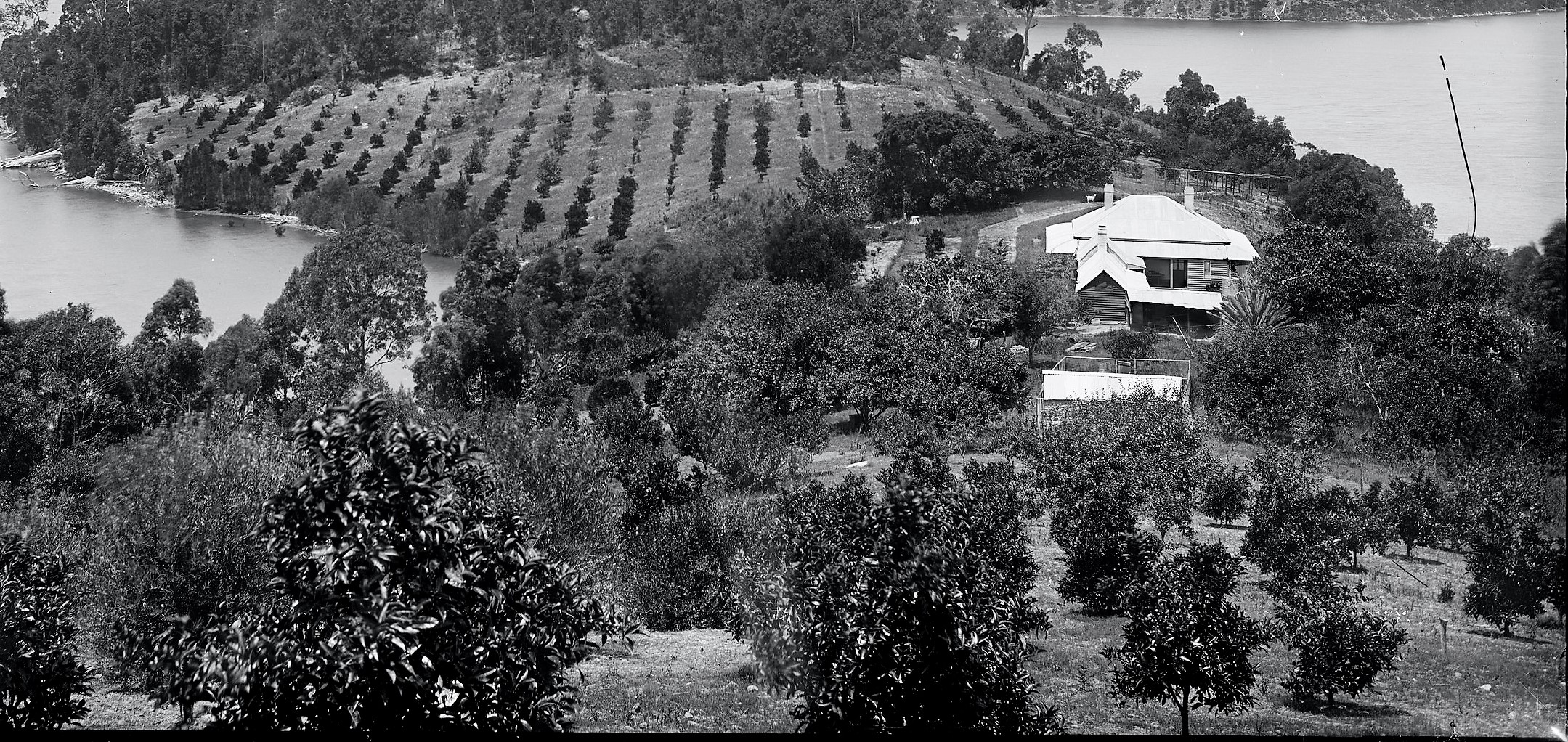
'Orange Orchard' by Charles Kerry, circa 1887-1888. From Tyrell Collection, courtesy Powerhouse Museum
Below: from Album 50: Photographs of the Allen family, May 1909 - 12 October 1909.jpg?timestamp=1757046228049)
Down by the waterside were millions of oysters, whose careless profusion suggested a flouted industry. A well-worn path under giant gums and sassafras trees led to a noted part of the grounds. Here was a waterfall tumbling fifty foot in smoke-like spray. The whole face of the cliff which was watered by the spray was covered with clinging plants, ferns, and funny looking creepers.
About this spot the vegetation was as beautiful and luxuriant as I ever remember having seen it in the mountains. There were fern trees, as tall as the stateliest in the mountain gullies. Bangaloes of magnificent size, and 40ft, upon the trunk of a glorious blue gum there was a mass of Staghorn ferns as big as small cottage. From the trees the rope-like Supple jack descended, and the bushes about fairly blazed with blossoms. So thick was the growth that it was impossible to force a way through it. A fairer spot there is not on the coast anywhere in the vicinity of Sydney.
A huge Government reserve runs, back from the shores of Pittwater to Gordon, and this also was unusually brilliant with all kinds of our beautiful, barbarously-named bush flowers. Tearing through this vegetation was splendid work, if somewhat trying to the clothes; and on reaching the elevated ground overlooking Cowan Creek: the guerdon was well worth the pleasant travail. Hundreds of feet below, blue as turquoise, Cowan Creek nestled in dark green environing hills. It is sea-blue in colour as well it might be, for it is an eccentric arm of the sea, which winds its way far into the bowels of the, land, being, in fact, the longest arm of Broken Bay. Anyone, however, would mistake it for a fresh-water river. On those breezy heights the draughts of fresh air to be inhaled are delicious. Over miles of eucalyptus leaves a deep balsamic gale rushes up charged with the health-giving qualities that the old settlers found so soon in the eucalyptus woods. After a long and arduous climb, of several hours I found almost instant recuperation in this elevated air, interfused with forest perfumes. It would be hard to be sick under the influence of this " balsam of the forest". A medical friend informed me that he got rid of an unusually persistent cough of many months duration by going to the mountains and chewing the young eucalyptus leaves every day. The virtues of the "gum-tree " are not unrecognised, but are not all known yet, and its place in medicine is, perhaps, destined to be one of great importance.
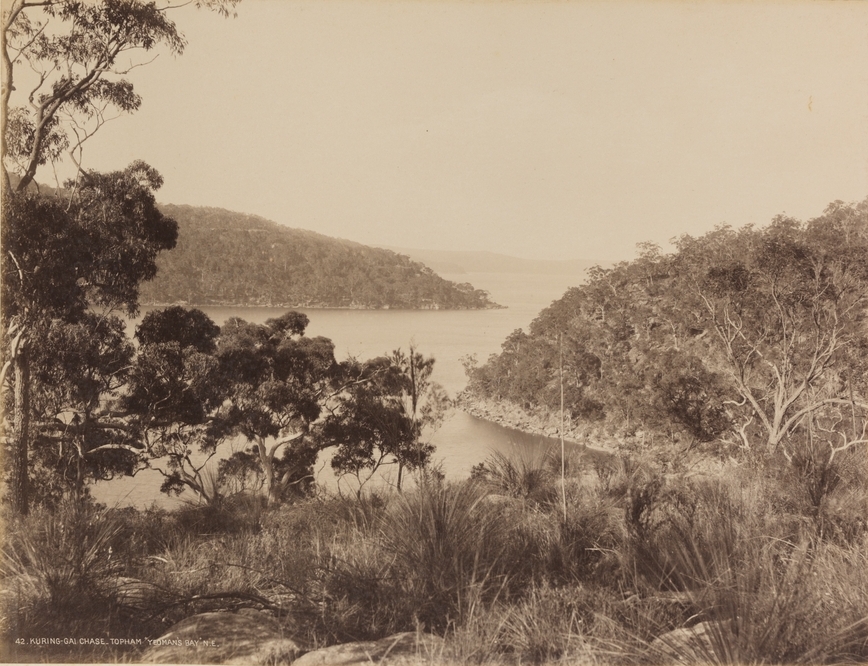
Yeomans Bay, from NSW State Library Album - Photographs - New South Wales, 1879 - ca. 1892 / N.S.W. Government Printer. Image No.: a924070h, courtesy State Library of NSW
On the rock beneath my feet were some curious drawings. A glance revealed them to be specimens of the initial artistic efforts of the Australian aboriginal. There were two figures - a bird and a fish - clumsy enough in all faith, but not without a close resemblance to the living originals. Some day they will have a deep interest to Australians, as relics of the old inhabitants and their totemistic religion. Beside the art glories of perfect Greece, how poor they are; and yet, as mythologists tell us, many of the religious rites and legends of the ... Australian blackfellow have their counter- parts in Greek myth. Truly, there is nothing new under the sun, and man is always man. The same instinct which moved the chisel of Phidias and the pencil of Apelles directed the pointed flint of the dusky artist of these rude rock sculptures.
As the setting sun fires splintering crag and bush-grown hill, and flings a purple glow over far inflowing waters, the birds twitter in one choral burst of song, and then grow still; and all the voices of Nature but one are still. The mists troop forth from their hiding-places and sit on the vacant thrones of the sunlight, and a dull insistent moaning down the bay tells us that the sea's sleep is disturbed by dreams of coming storm. The dawn sees us once more on our way to the "big smoke."
A RUN TO PITTWATER. (1889, September 21). The Sydney Morning Herald (NSW : 1842 - 1954), p. 7. Retrieved from http://nla.gov.au/nla.news-article13739295 * This is folklore, unproved.
Around this time the Manly Wildflower Shows, which also saw scores of people take to the bushland to pull everything out by its roots, saw the once glorious surrounds of Manly denuded of every wildflower. Having killed everything there they moved on to places such as Dee Why and Beacon Hill, once renowned for its carpets of flannel flowers. So much was killed so quickly these ceased to be able to run, and the profits they generated resulted in every human and wildlife generation since being robbed of what was once there - of the right to be able to just walk into the bush near their home and smell the flowers or gaze up at an ancient tall old tree.
The Manly wildflower shows in their day were things of joy and beauty, and a great attraction for visitors. The first show was originated by Mr. Hayes, along with the Rev. T. Willis, while the former was Mayor, Mrs. Hayes and other ladies joined heartily in the scheme, which was to raise funds for St. Matthew's Church, and afford an advertisement for Manly. Willing volunteers gathered in the wildflowers, which were then abundant all round Manly, and the initial function was an astonishing and gratifying success. Mrs. Hayes states that over £250 was taken by the ladies in the first two hours of the festival of flowers. Each succeeding year the shows grew in importance, and attracted thousands of visitors from the city. The Manly Wildflower Show became a yearly event for the whole of Sydney, and was a fine advertisement for the place. Thousands of pounds were raised, which went to helping the different churches, who took half the proceeds, while the council received the other for the Improvement of the reserves. It was from the money gathered from the flowers that the oval was filled in and brought up to its present satisfactory condition, and many other park improvements were made from the funds. With the increasing scarcity of wildflowers the flower shows died out, after nearly a dozen years of existence. OLD MANLY. (1912, April 28). The Sun (Sydney, NSW : 1910 - 1954), , p. 11. Retrieved , from http://nla.gov.au/nla.news-article228857438
See: Manly's Wildflower Shows: Some History

Manly Wildflower Show, date unknown. Photo: NSW State Records and Archives.
Patrick's brother Roderic also had laments for the destroyed bush:
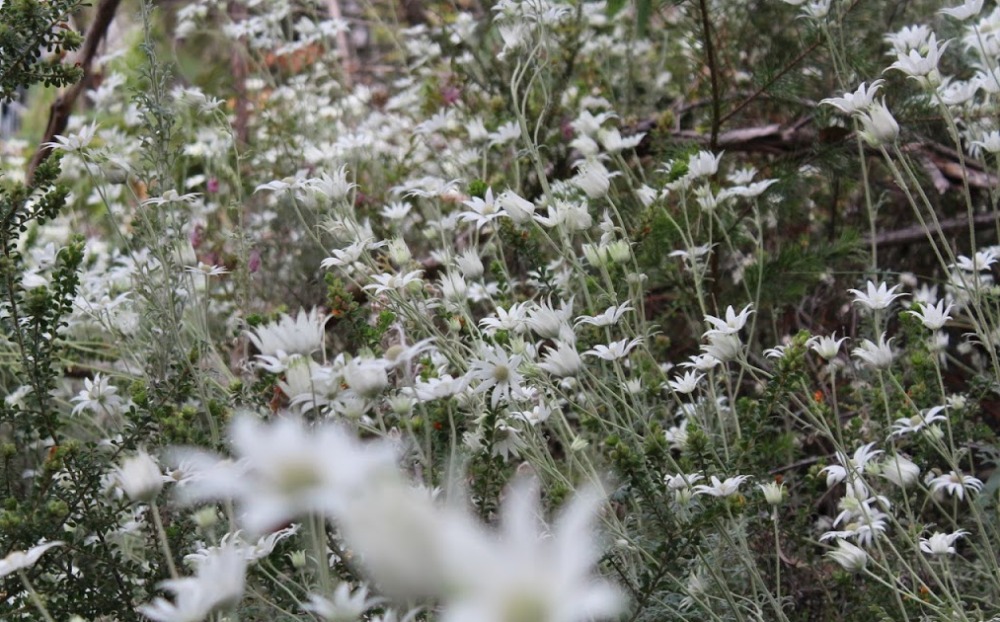
However, despite these champions of wildlife and plant habitat, the greed of a few destroyed the future of many:
ON THE LAND.
WILD FLOWERS.

In 1928 he became founding president of the Rangers' League of New South Wales—a volunteer group dedicated to preserving natural bushland and preventing bushfires. Many Pittwater residents were early members of this league, and others were Honorary Rangers of our local reserves under the Fauna Protection Act 1948 and the Wild Flowers and Native Plants Protection Act 1927-1945, roles which persisted into the late 1950's.
DESTRUCTION OF BIRDS
Palm Beach Sanctuary.
A passing motorist made a prompt response on Sunday to an appeal by Australian Bushland Conversation Association for assistance in getting the police to put a stop to indiscriminate shooting of birds on the Palm Beach road. Mr. J. D. Tipper, honorary director of the association, said that several of the bullets went dangerously close to motor traffic. One bullet struck the ground In the midst of a party of children. When the police arrived, the members of the shooting party dispersed. Many complaints have been received of the shooting of birds in the locality, which is a proclaimed sanctuary. DESTRUCTION OF BIRDS. (1933, March 2). The Sydney Morning Herald (NSW : 1842 - 1954), p. 10. Retrieved from http://nla.gov.au/nla.news-article16981792
Our Bird Life
BUSHLAND ASSOCIATION'S THANKS.
Appreciation is expressed by the Australian Bushland Conservation Association to an unknown motorist for his prompt response to an appeal by an officer of the Association for police assistance near Palm Beach on Sunday 26th February, when ''sports'' were shooting birds on the main road.
Mr. John D. Tipper, Hon, director of the A.B.C.A., stated that bullets whizzed dangerously close in dense motor traffic: one shot was aimed right into a party of children playing on the beach.
Many complaints have been received by the Association in regard to bird shooting in the locality, which is a bird sanctuary. Recently cows owned by an agent of the Association were maimed because of his alleged reporting of shooting. The A.B.C.A. hopes that its action in locating the offenders will remove a public menace and give protection to bird life. Our Bird Life (1933, March 9). The Gosford Times and Wyong District Advocate (NSW : 1906 - 1954), p. 11. Retrieved from http://nla.gov.au/nla.news-article167863804
THE RANGERS' LEAGUE.
(To the Editor).
Sir, — The Rangers' League, which was established for the purpose of giving practical service in its work covering the protection, and preservation of our unique and wonderful Australian Flora and Fauna and the other natural and special features of our country, has already made surprising progress.
Being the first organisation of its kind, the work of the League has been mainly pioneering. Much field work has. been accomplished valuable assistance has been rendered by the Government, and also 'by public and private organisations ; this . has helped in large measure to bring about the success 'which has been achieved. The team work of the members, the general increasing . interest, and the - praise and sympathy received from many sources, are very encouraging.
The' League, is under the control of a Council representative of its manifold, activities, such as ecology, botany, etc!, while the more immediate supervision is entrusted to an executive. The service rendered by the members is given in a purely honorary' capacity, and each member is expected to contribute assistance in some form; this service is supplemented, as far as possible, with available funds.
Several acts, of great interest to Rangers, are in course of amendment by Parliament,- and it is pleasing to note that suggestions by the League for the amendment of the Birds and Animals Protection Act have been accepted and included. The continued success of the League depends upon the individual and united effort of each of us. It is the duty of all Australians to do their utmost to protect and preserve our native birds, animals. plants and flowers, which are becoming more rare and even extinct. In our own interest and in that of our children, these must be regarded as an everlasting heritage to be handed down to future generations: As a means to that end, the -League is commended to you ~f or your generous support. Th secretary will be pleased, to receive inquiries from individual Rangers and all others who are interested. — Yours, etc., J. D, TIPPER, President. THE RANGERS' LEAGUE. (1930, June 21). Molong Express and Western District Advertiser (NSW : 1887 - 1954), p. 2. Retrieved from http://nla.gov.au/nla.news-article139979951
- Annie Wyatt Reserve, Palm Beach: Pittwater Fields of Dreams II - The Tree Lovers League
- Muogamarra Nature Reserve in Cowan celebrates 90 years: a few insights into The Vision of John Duncan Tipper, Founder
- Stokes Point Careel Bay: the Shift from Warner's hut in 1813 to Finisterre in 1924; 1934 additions probably designed by Australia's first Female architect, Beatrice (Bea) May Hutton - A Pittwater Rendezvous site for Royal Sydney Yacht Squadron members is still a home with a view for those with a passion for sailing
- Grand Old Tree Of Angophora Reserve (Avalon) Falls Back To The Earth
APPOINTMENT OF HONORARY RANGERS.
WILD Flowers and Native Plants Protection Act, 1927:— The undermentioned persons have been appointed as honorary rangers for the purposes of this Act:—
Brammer, John, Kyneton, Bassett-street, Mona Vale; Collins, Edmund Henry, Ocean Grove, Collaroy; Gould, Charles Sidebottom, Daintree, Salvation-street, Mona Vale; Gould, (Mrs.) Margaret Irene, Daintree, Salvation-street, Mona Vale; Hawkins, Harold Frederick Weaver, Water view-street, Mona Vale; Hawkins, (Mrs.) Irene Eleanor, Waterview-street, Mona Vale; Keiitwell, Graham Harold, Elimattastreet, Mona Vale; Kcntwcll, (Mrs.) Eunice, Elimatta-street, Mona Vale; Myers, (Mrs.) Enid, 29 Lueretia-avenue, Longueville; Savage, (Miss) Ethnee, Bayview-road, Mona Vale; Savage, (Mrs.) Fanny Stephney, Bayview-road, Mona Vale; Toovey, (Miss) Roslyn Phyllis, Hillcrest-avenue, Mona Vale; Young, (Miss), Annie Lawson, The Tropics, Crescent-road., Mona Vale. (3144) J. J. CAHILL, Minister for Local Government. APPOINTMENT OF HONORARY RANGERS. (1945, June 15). Government Gazette of the State of New South Wales (Sydney, NSW : 1901 - 2001), p. 1032. Retrieved from http://nla.gov.au/nla.news-article225482291
APPOINTMENT OF HONORARY RANGERS.
FAUNA Protection Act, 1948.—The undermentioned persons have been appointed as Honorary Hangers for the purposes of the abovenamed Act:—
Mr. William Norman Barry, Tirranna, Goulburn; Mr. William Henry Weston, Muttama, Darley-street, Mona Vale; Mrs. Essie May Weston, Muttama, Darley-street, Mona Vale; Mr. Allan Eoy Sefton, 17 Station-street, Tliirroul; Mr. Eichard Tamblyn Crago, Mount-road, Bowral. (A. 53-856, A. 53-1,047, A. 531,142, A. 53-1,178) (6748) C. A. KELLY. APPOINTMENT OF HONORARY RANGERS. (1953, July 17). Government Gazette of the State of New South Wales (Sydney, NSW : 1901 - 2001), p. 2292. Retrieved from http://nla.gov.au/nla.news-article220066768
WILD FLOWERS AND NATIVE PLANTS PROTECTION ACT, 1927-1945.
Appointment of Honorary Rangers.
THE undermentioned persons have been appointed as Honorary Rangers for the purposes of this Act:—
Edward Selwyn Holmes, 18 Queens-avenue, Avalon Beach; Katherine St. George Holmes, 18 Queens-avenue, Avalon Beach; Edward Gordon Sellers, "Deerholt", Plateau-road, Avalon; Audrey Enid Sellers, "Deerholt", Plateau-road, Avalon; Arthur Eric Brown, "Wirrabilla", Hill-top road, Clareville; Saidee Kathleen Brown, "Wirrabilla", Hill-top road, Clareville; Harrie Humphreys, 74 Avalon-parade, Avalon; Marjorie Ethel Humphreys, 74 Avalon-parade, Avalon; Allan McDonald Warden, 63 Avalon-parade, Avalon; Isabella Olive Warden, 63 Avajon-parade, Avalon; Percy Robert Hillier, 7 George-street, Avalon; William August Miller, Paradise-avenue, Paradise Beach; William James McDonald, Avalon-parade, Avalon; Harold Alfred Seymour, Old Gordon-road, Foley's Hill, Mona Vale; Reginald William Squire, "Aranui", Cabarita-road, Clareville Beach; Herbert Strickland Rice, "Lorne", Riverview-road, Clareville.
(872) J. B. RENSHAW, Minister for Local Government.
WILD FLOWERS AND NATIVE PLANTS PROTECTION ACT, 1927-1945. (1955, May 6). Government Gazette of the State of New South Wales (Sydney, NSW : 1901 - 2001), p. 1254. Retrieved from http://nla.gov.au/nla.news-article220300810
Pittwater is a place enriched by its aquatic, bush, coastal saltmarsh, heath and coastal swampland environments and being able to see what other species live here in these places. Although this area is much-changed after Europeans settled here, urban areas are still home to ringtail and brushtail possums, bandicoots, flying foxes, snakes, water dragons and goannas, and hundreds of species of nocturnal and diurnal birds.
However, when humans put themselves first, last and always, and compound ignorance with arrogance, this self-entitled selfishness leads to the extinctions of other species that foretells our own extinction, possibly in the same horrible ways.
As we head into Spring, and more and more wildflowers come out, and baby wildlife species will be seen trying their first steps outside the nests and burrows, an opportunity to be part of the solution instead of part of the problem presents itself.
The NSW Department's 2025 National Threatened Species Day, told by a lady who has witnessed almost a century of this destruction of animals, that feel and think and mourn the loss of family members as much as any member of the human species does, is well placed to hopefully inspire others to go in the opposite direction - for life.
Please be aware before watching this that there are dead and extinct wildlife species in this film - it may not be suitable for small children - even adults will be upset - but worth watching for the messages it brings.